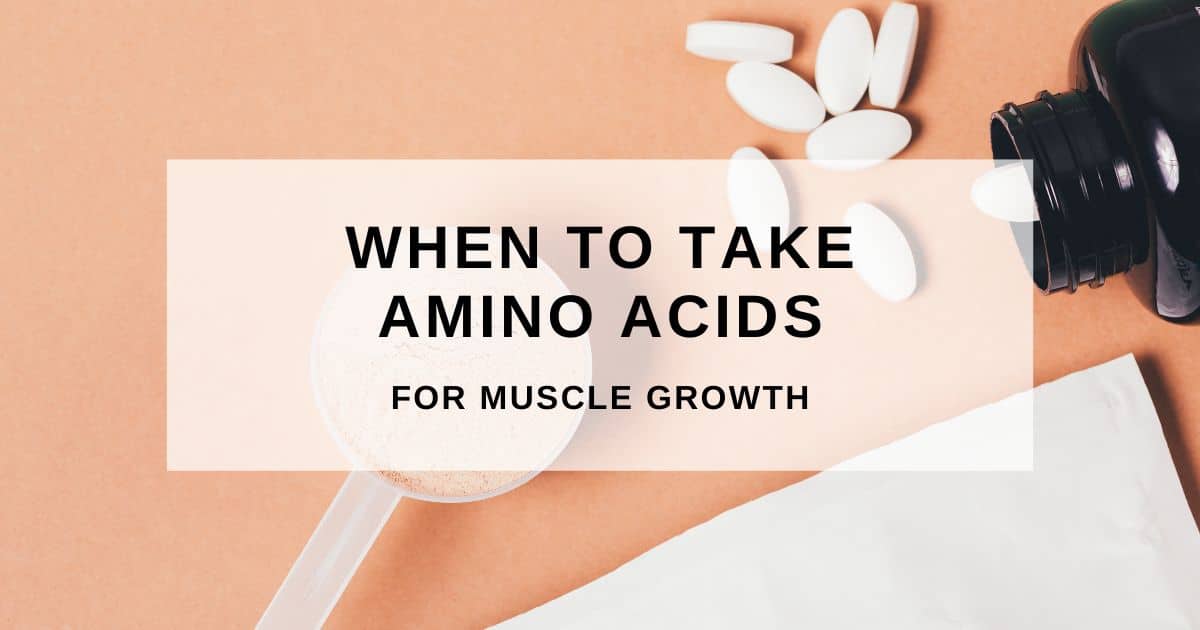Essential amino acids (EAAs) and branched-chain amino acids (BCAAs) are popular supplements that can help build muscle and improve endurance. Here we review the similarities and important differences between EAAs vs BCAAs to help you determine which supplement can help you the most!
What are amino acids?
Amino acids (AAs) are often called the “building blocks of protein.” They are organic compounds made of oxygen, nitrogen, carbon, and hydrogen.
Amino acids are necessary to form proteins; create enzymes, hormones, and neurotransmitters; provide energy for the body; break down food; absorb nutrients; build muscle; boost your immune system; and repair body tissues.
What are EAAs?
Essential amino acids
Essential amino acids (EAAs), also called indispensable amino acids, are a group of 9 amino acids that our bodies don’t make and must be consumed from food or supplements. They include the following:
- Histidine, isoleucine, leucine, lysine, methionine, phenylalanine, threonine, tryptophan, valine
Non-essential amino acids
Nonessential amino acids (NEAAs), also called dispensable amino acids, are the 11 amino acids the body makes innately. While you usually do not need to get these from your diet, they are still present in many foods and serve important functions. They include the following:
- Alanine, arginine, asparagine, aspartic acid, cysteine, glutamic acid, glutamine, glycine, proline, serine tyrosine
Conditionally essential amino acids
Conditionally essential amino acids (CEAAs), also called semi-essential amino acids, include certain non-essential amino acids with higher requirements during increased growth, illness, or injury. Your body makes limited NEAAs, so if your requirements increase, you must obtain more from your diet. They include the following:
- Arginine, cysteine, glutamine, tyrosine, glycine, proline, serine
What are BCAAs?
Branched-chain amino acids
Branched-chain amino acids (BCAAs) are a group of 3 essential amino acids that contain a branched side-chain. They include the following:
- Isoleucine, leucine, valine
BCAAs are mostly popular because of leucine’s role in muscle protein synthesis (MPS).
Muscle protein synthesis is the process of building new muscle tissue, and it occurs when protein (or amino acid) consumption exceeds muscle protein breakdown (1).
Leucine is a primary trigger for MPS. It helps prevent muscle protein breakdown and increases skeletal muscle size and mass (2, 3, 4, 5).
Food sources of EAAs vs BCAAs
Food sources high all 9 EAAs:
- Meat, poultry, fish, eggs, dairy, soybeans
Food sources high in all 3 BCAAs:
- Meat, poultry, fish, cottage cheese, eggs, legumes, sesame seeds
Benefits of EAAs vs BCAAs
General functions and benefits of amino acids
- Boost the immune system
- Growth and repair of body tissues
- Aid digestion and absorption of food
- Maintain healthy hair, skin, and nails
- Regulate mood, sleep, and cognitive function
- Produce enzymes, hormones, and neurotransmitters
Exercise and muscle growth benefits of amino acids
- Prevent muscle breakdown and promote muscle repair
- Increase exercise endurance by providing an energy source to the muscles
- Assist in building muscle mass after strength training by triggering muscle protein synthesis
- Increase basal metabolic rate to aid in weight control and improved body composition
- Regulate blood sugar by promoting insulin release and glucose uptake by the muscles during and after a workout
Benefits specific to EAA supplements
- Decrease fatigue, soreness, and recovery time due to rapid use by the muscle for rebuilding (6)
- Promote greater muscle protein synthesis than BCAAs since all essential amino acids are needed for muscle growth (6, 7)
- When consumed pre-workout, they may decrease delayed onset muscle soreness (DOMS) and improve the quality of strength training sessions (8, 9)
- Prevent amino acid imbalance which may be seen when taking BCAA supplements (BCAA supplements may cause amino acids to be pulled from other tissues into the muscle) (10)
- Preserve muscle mass during calorie restriction
Benefits specific to BCAA supplements
- Due to their structure (having a branched chain), BCAAs bypass the liver during digestion and are sent straight to muscle and brain tissue, allowing immediate use and providing a quick energy source (11)
- BCAA supplements contain a significant source of leucine which activates the mTOR pathway to initiate muscle protein synthesis (MPS) (12)
Do you need amino acid supplements?
You probably don’t need amino acid supplements if you eat a varied diet with most of your protein coming from complete protein sources, like meat, poultry, fish, eggs, dairy, whey protein, and soy.
If you eat a vegan diet with a variety of soy, legumes, and grains, you can still meet your amino acid needs by increasing your protein intake a little.
It is best to eat whole food sources of protein as much as possible since they also contain vitamins, minerals, fiber, and other nutrients. However, some people like the convenience and quick energy source supplements provide.
Who can benefit from EAA supplements?
- People with very high protein needs
- People who don’t tolerate high food volume
- People following a vegetarian or vegan diet
- People eating in a calorie deficit to promote weight loss
Who can benefit from BCAA supplements?
- People who meet their amino acid needs from other protein sources but want an additional boost of amino acids (or leucine) to aid in muscle building and exercise performance
- People who want a quick energy source to fuel their muscles during exercise
Dosage & timing
These are the ideal doses for EAAs vs BCAAs:
- EAAs: 10-20 grams (6)
- BCAAs: 5-10 grams (6)
- Ideally a 2:1:1 ratio of leucine to isoleucine to valine
These are the ideal times to take EAAs & BCAAs:
- 30 minutes before exercise: prevents muscle catabolism and damage during exercise, provides a source of energy to the muscles, and stimulates muscle protein synthesis (13, 14).
- During or after exercise (within 2 hours): will also stimulate muscle protein synthesis, but may have less effect on preventing muscle breakdown (6).
- Between meals: consume EAAs between meals to help meet protein needs (6)
Taking amino acid supplements with a carbohydrate source (like fruit juice or dextrin) creates a more anabolic state and can increase muscle protein synthesis.
Which is better for muscle building & meeting protein needs?
While both EAAs and BCAAs offer benefits for muscle building, EAAs are superior if you need help meeting your protein needs. EAAs may also promote greater MPS, though BCAAs may be just as effective if you meet your overall protein needs and obtain all of the EAAs from other food sources.

Final thoughts
EAAs and BCAAs can help fuel your workout and promote muscle repair and growth. EAAs may offer more benefits overall and help you meet your protein needs, especially if you have difficulty eating enough protein from varied sources throughout the day.
With both BCAAs and EAAs, there are plenty of flavor options, and some products also contain other endurance and muscle-boosting ingredients, like caffeine, creatine, or electrolytes, so there is undoubtedly something for everyone!
Frequently Asked Questions
EAAs may offer more benefits than BCAAs and can help you meet your protein needs, especially if you have difficulty eating enough protein from varied sources throughout the day.
EAAs may also promote greater muscle protein synthesis, though BCAAs may be just as effective if you meet your overall protein needs and obtain all of the essential amino acids from other food sources.
Taking both EAAs and BCAAs may be beneficial to ensure you get all nine essential amino acids plus a higher dose of leucine (from the BCAAs) to promote optimal muscle protein synthesis.
The best time to take an EAA supplement is 30 minutes before your workout. This prevents muscle catabolism and damage during exercise, provides energy to the muscles, and stimulates muscle protein synthesis.
Taking EAAs during or within two hours after exercise is also beneficial but may not be as effective as before.
You can also take EAAs between meals on days you don’t exercise or days you struggle to meet your protein needs.
Muscle growth requires consistent strength training with progressive overload and adequate protein intake. Essential amino acid supplements can help build muscle through their involvement in muscle protein synthesis and by meeting protein needs to create new muscle tissue.
Want to save this article? Click here to get a PDF copy delivered to your inbox.
This page may contain affiliate links. If you choose to purchase after clicking a link, I may receive a commission at no extra cost to you.
Collette is a registered dietitian and has over a decade of experience working with athletes, children & adults on tube feeding, and people with chronic health conditions. She has been writing about food and nutrition since she was in high school and has a passion for sharing evidence-based information, especially on the topics of protein and the importance of maintaining muscle mass for healthy aging.




